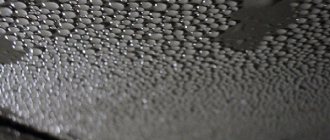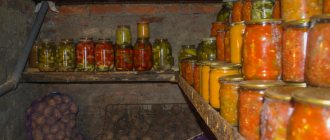There is dampness on the ceiling in the cellar
There is dampness on the ceiling in the cellar, then this is the first signal that measures must be taken to eliminate it. Today we will tell you how to eliminate dampness in the cellar.
This is not just work, it is a set of measures to eliminate moisture penetration. First of all, you need to determine why the cellar is damp. After all, nothing just happens. After this, decide how to get rid of dampness in the cellar.
In this article we will look at several of the most acceptable options for doing the job. You can also see photos and videos on this topic.
Formation of dampness in the cellar
Eliminating dampness from the cellar must begin by determining the point of penetration of moisture into the room. After all, increased dampness and humidity in the room lead to the formation of fungus and mold, which contribute to the spoilage of the products stored there.
Humid air is formed by capillary action; in other words, small drops of water enter the earthen floor through cracks, then the moisture begins to evaporate, resulting in an increase in air humidity. It should be noted that sandy rocks rise water much more slowly than clay rocks.
Before you start fighting dampness in the cellar, you need to determine the reasons for its occurrence:
- One of the reasons may be poor insulation of the house. Because of this, in cold weather, moisture will enter the walls of the house, contributing to the formation of mold. This phenomenon can often be observed in the upper corners of the walls, because moisture enters the room from above (from the roof).
- In addition, moisture can penetrate into the cellar through groundwater . Another cause of mold may be the lack of waterproofing under the floor.
- You also need to pay attention to the drainage system in the basement. After all, if water accumulates near the cellar, it may well penetrate inside the room.
Insulation
A relatively inexpensive, but quite effective way to avoid problems with condensation in a garage building is to insulate it. But before starting insulation work, you should remember that when carrying out the work, the type of garage building must be taken into account, which can be carried out in the form of:
- separate capital structure;
- premises built into a residential building;
- in the form of an extension.
In addition to the above options, it can also be a temporary structure, which is a prefabricated structure made from standard sheet metal blanks or a so-called shell garage. When insulating your building, the material used in its construction (metal sheets, brick or concrete blocks) must also be taken into account.
Depending on the above characteristics of the garage structure, a variety of types of insulation can be used to insulate its walls and ceiling, including the following names:
- mineral wool in mats;
- foam blanks or penoplex;
- polyurethane foam or polystyrene foam boards;
- regular backfill made of expanded clay.
Mineral wool
This is how metal garages are insulated with polyurethane foam:
Methods for dealing with dampness
Now let's look at how to get rid of dampness in the cellar in more detail. Today, there are several ways to combat indoor humidity.
Removing dampness from a cellar can be done using several methods:
- One of them is concreting the floor and walls of the basement plus the use of liquid glass and roofing felt.
Attention: We recommend that you pay attention to the use of an inexpensive method of getting rid of moisture. It consists of using polyethylene film (the use of previously used film is allowed). In addition, you will need a shovel, trowel and clay.
In cases where your cellar has a clay floor, this clay can be used to speed up the work. To do this, clay must be added to the waterproofing layer.
The work is carried out as follows:
- Remove a layer of clay 5 cm thick.
- Level the floor surface and cover it with plastic film folded in half.
- Clay is poured on top of the film and compacted well. Clay can be replaced with concrete.
- After the clay dries, the humidity level in the cellar will noticeably decrease and the air will become much drier.
It also happens that the humidity level increases in the autumn and spring periods. This is directly related to precipitation.
In this case, another method will be effective, which needs more detailed consideration:
- A 10 cm thick layer of sand or gravel is poured onto the floor. If the humidity level continues to rise, a layer of gravel is added. This ensures that the groundwater level is lowered to the point where moisture cannot rise to the floor level in your cellar.
- To get rid of moisture that appears due to the accumulation of condensation, you should use a special waterproofing plaster. The use of this method allows the floor and walls to breathe.
- For these purposes, it is allowed to purchase ready-made waterproofing mixtures, which you can make yourself. It is obtained by mixing a waterproofing additive with dry plaster.
Attention: Before applying the mixture to the walls and floor, they must first be cleaned of mold and mildew using a special product (fungus removal solution).
Causes of dampness in the cellar
If the cellar is damp, then we immediately determine the reasons and then think about how to remove the dampness from the cellar.
How to dry a basement after a flood
When flooding occurs, water is pumped out with a drainage pump.
Most property owners have to deal with this phenomenon after snow melts or heavy, prolonged rainfall. The problem is serious and you need to get rid of it as quickly as possible, since water has a destructive effect on the cellar, its contents, foundation and garage walls.
The first step is to remove the liquid from the pit. Considering that there may be several cubic meters of it there, you should use means of mechanization. Scooping with a bucket may take several days.
- Motor pump. You can rent it or contact a rescue service that has similar equipment. If flooding situations tend to occur regularly, it is advisable to buy the product and always have it on hand.
- Ilosos. Calling a sewage disposal truck solves the problem of pumping out and at the same time disposing of dirty water, most likely contaminated with pathogens.
After getting rid of the water, you need to remove all the food, things and furniture located there from the cellar. Based on their condition, a decision is made regarding restoration or disposal to a landfill. Then you need to clean the room from accumulated contaminants. They are first cleaned with a scraper, then with a brush, and finally wiped with a rag soaked in a chlorine solution. Next you need to assess the damage caused to structures. If necessary, they are repaired, strengthened, and ventilation ducts are cleaned.
After this, all that remains is to dry the cellar in the garage. This must be done immediately, using all available means and possibilities.
Folk ways to deal with dampness in the basement
Dampness in the cellar can be eliminated using folk remedies. These are sometimes quite effective methods and the cost of the work will be trifling.
Among such methods are the following:
Ventilation and waterproofing of the cellar
- One of the simplest methods involves installing containers filled with white moss powder on the floor and shelves of the basement. This is an excellent adsorbent that absorbs moisture and dries the room.
- You can remove moisture using hydrochloric acid. To do this, you need to empty the basement of all the products there. Hydrochloric acid is diluted to obtain a weak solution, which is used to lubricate the walls and shelves in the room. This must be done with rubber gloves, otherwise you may get acid burns.
- Another option is no less effective. Place a ceramic or glass (but not metal) container filled with table salt on the floor. Then sulfuric acid is poured into it. The vapors released during the chemical reaction contribute to the destruction of mold and mildew that has formed on the walls and shelves of the room. This procedure requires thorough ventilation. In addition, it is a good idea to wash the walls after the procedure.
- Slaked lime works great for drying walls. A container with slaked lime is placed in the corner of the basement.
- Damp cellar walls can be dried using simple clay bricks. For drying, it is enough to place two or three heated bricks in the basement. As they cool, they will begin to actively absorb moisture. After the ceramic bricks have cooled, reheat them. A simplified version of this method is a fireplace installed near a damp wall. It helps warm up the damp, moldy area in the cellar.
- It must be said that mold that has settled on the walls of the cellar does not tolerate an acidic environment. It can be washed off with acetic, boric or citric acid.
- Dampness in the cellar can be eliminated with the help of diesel fuel, unless, of course, you have food stored there. Treat damp walls with diesel fuel, then whitewash them with lime whitewash.
Eliminating dampness in the cellar is sometimes a rather labor-intensive process, and therefore it is best to properly make the drainage system and waterproofing at the construction stage. Then dampness will definitely not appear in the cellar.
And you don't need instructions to do the job. But if water does penetrate, then one of the methods will definitely help you.
Penetrating waterproofing
This technology also refers to the effective modern methods by which basements and basements are waterproofed. The operating principle of the method is based on the creation of new structural connections in the structural material. When applying the coating, all pores and capillaries are blocked. The first mixture of this effect was released by the Danish company Vandex. Among the well-known domestic products are “Aquatron”, “Gidrohit”, “Lakhta”, “Kalmatron”, “Coral”, etc.
Cellar waterproofing diagram.
The composition can quickly treat concrete or brick walls without having to dig them up for waterproofing work. Before treatment, the surface is cleaned of dirt, dust, oil stains, etc. If the wall is covered with mold, it must be cleaned and then treated with an antiseptic solution.
In the seams between structural material elements, it is necessary to make grooves about 2 cm deep. Visible cracks should be widened with a spatula to a width of at least 20 mm and deepened by 25 mm or more.
The mixture is diluted with water and applied to a pre-moistened surface. Reacting with water, the composition crystallizes on the surface of the structure and densely fills the pores of the material. You should not prepare a lot of solution at once. A volume of the mixture is mixed at one time to work for 30 minutes. The prepared composition is applied with a brush, spatula or spray gun.
After final processing and drying of the cellar, you can bring in the removed items, having previously treated them with an antiseptic acrylic solution or copper sulfate solution to remove remaining traces of mold.
Why is lack of ventilation harmful?
Why is it necessary to remove dampness from the garage? According to SNiP, ventilation in a garage should provide an influx of fresh air with a volume of at least 180 cubic meters per hour. This is what guarantees safety, the absence of high levels of humidity, and the safety of the car from rust.
As a result of such a problem, the following consequences may arise:
- Dampness. Excess moisture provokes the appearance of toxic fumes from fuel, oils, and lubricants.
- Body corrosion. If the car is not dried, that is, the condensation that covers it is not eliminated, then this leads to the appearance of rust areas on the body. The walls of the metal garage are also damaged.
Harm from mold to humans and buildings
If the owners see mold in the basement of a wooden house, how to get rid of it must be decided immediately, before the problem goes far. After all, fungus can negatively affect the health of all family members, the condition of the basement itself and the house. Mold causes the following damage:
- reduces the service life of finishing and building materials, shelves and racks made of wood;
- affects concrete floors, which begin to crumble and lose strength;
- harmful fungal waste products enter the house or garage if the cellar is located underneath them;
- vegetables and fruits are also affected by mold, the products acquire an unpleasant “aroma” and spoil;
- Mold in the basement also negatively affects human health - its toxins cause headaches, nausea and vomiting, lung diseases, coughs and runny noses, and allergies.
Don't delay - it's time to act
If you notice that condensation has appeared in the garage, do not delay the work until later, as this may lead to damage to the car. This must be done based on the reason for the appearance of increased humidity levels.
Dampness in the garage can appear for various reasons, but this situation cannot be left without solving the problems. A damp garage is the first step to rust, which leads to breakdowns and damage to property. This problem can be solved in various ways, but the most effective are installing a garage ventilation system and waterproofing the floor and inspection pit.











